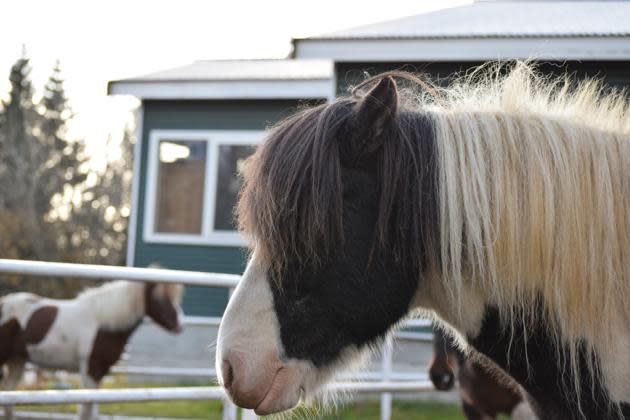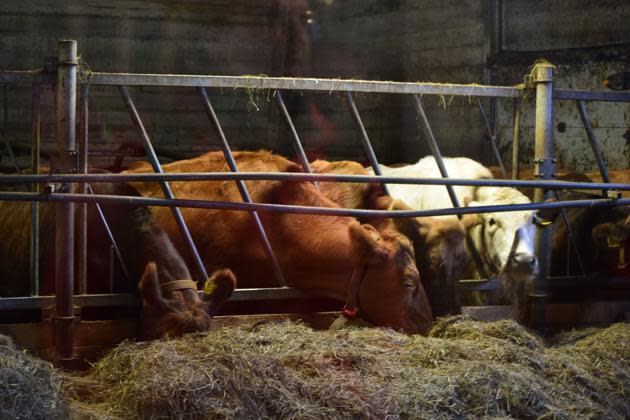Climate Change Is a Boon to Tourism in Iceland
On April 14, 2010, Iceland’s Eyjafjallajökull volcano erupted. As a cloud of ash headed toward Ólafur Eggertsson’s picturesque farm nestled in the foothills, he gave his cattle a four-day supply of food, plugged cracks in the barn, then evacuated with his family. Over the next few months, the family filmed their efforts to restore their home and eventually created a 20-minute documentary. A year after the eruption, the family opened a visitor center across the street from the farm to show the film and sell knick-knacks, including bottled ash, to the booming number of tourists that followed in the wake of the eruption.
More than 2.2 million tourists—roughly six times the country’s population—are expected to visit Iceland this year for the rugged beauty, glaciers, volcanoes, Northern Lights, and perhaps surprisingly, agriculture. “Agritourists” are people who travel to enjoy local food and a taste of the agrarian lifestyle, and even on this isolated Arctic island, agritourism is taking off. “Tourism isn’t just a business, but a cultural force,” said Gudrún Gunnarsdóttir, the director of the Icelandic Tourism Research Centre, at the October 2016 Arctic Circle Assembly.
Recommended: Trump's Giant Climate Executive Order Is Here
The ongoing tourism surge, sparked by a post-eruption marketing push and fueled by cheap airline deals, has helped stabilize Iceland, which was hit hard by the 2008 financial crisis. As visitors have flooded in and discovered the country’s idyllic pastoral landscapes, agricultural demand has increased dramatically. And, as Iceland melts, climate change is expanding the crop possibilities to meet it.

(Virginia Gewin)
The Eggertssons are among the farmers who have been exploring ways to take advantage of Iceland’s changing climate. They’ve experimented with barley varieties for decades, and, more recently, with wheat and canola, crops once unthinkable above 60 degrees latitude. The canola serves as cooking and biodiesel oil. And the barley is a high-quality forage crop for more productive cows, as well as an ingredient for bread, beer, or whiskey.
Recommended: No, We Can’t Say Whether Cancer Is Mostly Bad Luck
Like all Icelandic dairy farmers, the Eggertsson family raises a small-bodied breed of cows brought from Norway by Vikings more than 1,000 years ago. Genetically isolated since then, this uniquely diverse breed is adapted to the harsh environment—and the secret behind Iceland’s ludicrously luscious dairy products. The butter is otherworldly; the ice cream is a dream.
These heritage breeds are a symbol of national pride. “The entire country is one big gene bank,” says Ólafur Dyrmundsson, a white-capped sheep farmer who recently retired as spokesman for the Farmers Association of Iceland. Livestock on Iceland has a reputation as a healthy, pure product—free from diseases, and therefore, medications.
Icelanders have opted not to import foreign dairy cows, and they are now reaping the benefits of deliberate steps to conserve their agricultural heritage. Over the years, farmers have toyed with lifting a ban on imported cattle in order to breed with animals able to produce more milk. Instead, through progressive breeding improvements and good management, including better quality feed like the Eggertssons’ barley, they have steadily increased milk production volumes to roughly 65 percent of a Holstein, according to Dyrmundsson.
Iceland maintained their cultural heritage, most notably a hearty breakfast staple, in the process. Icelandic skyr is a thick, high-protein traditional yogurt produced from local milk and cultures that have been preserved in the country for centuries. Skyr from Icelandic Provisions, a cooperative of around 650 milk producers in the country, became available in U.S. grocery stores last year.
“I’ve actually had to tell people these are cows, not horses.”
“Commercial production is the best way to conserve endangered breeds,” says Áslaug Helgadóttir, a former agronomy professor at the Agricultural University of Iceland. But heritage livestock breeds are disappearing around the world. Half of European livestock breeds alive prior to the 1900s are now extinct—taking their genetic diversity with them.
In recent years, large groups of tourists have begun to visit in September to ogle roundups of horned Icelandic sheep as they are gathered from communal rangelands or ride gorgeous Icelandic horses, their manes flowing. (Older Icelanders take mild offense that few tourists want to eat horse meat.) Agritourism, says Philip Sponenberg, a professor of pathology and genetics at Virginia Tech’s College of Veterinary Medicine who studies livestock conservation, takes advantage of efforts to conserve unique breeds. Farms like the Efstidalur dairy and hotel have successfully incorporated tourism into their dairy production. Ice cream-eating tourists can gaze at grazing cows through a glass window to the barn.
Recommended: How Right-Wing Media Saved Obamacare
Sölvi Arnarsson grew up on Efstidalur and has helped transition operations to include a farm stay and restaurant. He’s amazed by the questions tourists ask about farming. “I’ve actually had to tell people these are cows, not horses,” he says. He hopes their agritourism business can help close the widening gap between urban tourists and rural dwellers.
Still, there is a growing concern that the spike in tourists may prove to be a double-edged sword—and could alter the authentic agrarian culture tourists seek, says Laufey Haraldsdóttir, a researcher who studies food tourism at Holar University College in north-central Iceland. Many small and medium-sized family farms struggle to stay afloat, particularly as youth move away from rural areas. And as tourism becomes a reliable, year-round business, some farmers, particularly in southwestern Iceland, have left farming and built tourist accommodations on prime farmland.

(Virginia Gewin)
“People, of course, want to hold onto our history and give guests insights into rural culture, but then they get so busy with all the tourists coming, it’s hard to hold onto traditional farming while offering tourists good service,” says Haraldsdóttir.
Worse, says Dyrmundsson, would be a move to intensive factory farming that would further destroy agrarian culture. According to Helgadóttir, the number of dairy farms has decreased as mechanization has increased efficiency and the size of remaining farms has grown.
Keeping farmers on the land is a way both to attract tourists and to preserve Iceland’s agricultural future, Dyrmundsson says. By conserving the tremendous bank of genes for both production quality and environmental adaptability, Icelanders are holding onto traits that may prove useful as the planet warms. Helgadóttir is convinced Iceland can produce much more food than it does currently. She works with farmers like Eggertsson to develop hardier barley and grass varieties to increase the sustainability of forage production. In a sense, this is what tourists marvel at—Icelanders’ unbridled self-sufficiency.
The question is whether the Arctic island can harness agritourism without losing the culture it is built on. “The most important thing is for Icelanders to hold onto our culture and protect our nature, while giving tourists—our guests—an authentic experience,” says Haraldsdóttir.
Read more from The Atlantic:
This article was originally published on The Atlantic.
